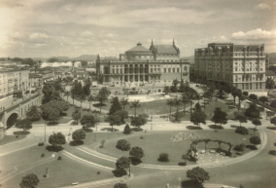Modern Art Week

TheModern Art Week(Portuguese:Semana de Arte Moderna) was anarts festivalinSão Paulo,Brazil,that ran from February 10 to February 17, 1922. Historically, the Week marked the start ofBrazilian Modernism;though a number of individual Brazilian artists were doing modernist work before the week, it coalesced and defined the movement and introduced it to Brazilian society at large.
The Week took place at theMunicipal Theaterin São Paulo, and included plastic arts exhibitions, lectures, concerts, and reading of poems. In its breadth it differed significantly from the Armory Show, with which it is often compared, but which featured onlyvisual art.It was organized chiefly by painterEmiliano Di Cavalcantiand poetMário de Andrade,in an attempt to bring to a head a long-running conflict between the young modernists and the cultural establishment, headed by theBrazilian Academy of Letters,which adhered strictly toacademicism.[1]The event was controversial at best and divisive at worst,[1]with one member of the Academy,Graça Aranha,ostracized for attending. He had opened the week with a conference titled "The aesthetic emotion in modern art". Due to the radicalism (for the times) of some of their poems and music, the artists were vigorously booed and pelted by the audience, and the press and art critics in general were strong in their condemnation (such as in a famous episode by editor, writer and art criticMonteiro Lobato).[1]
The group that took part in the Week, contrary to their initial intentions, did not remain a unified movement. A number of separate groups split off, and the original core members had separated by 1929. Two divisions predominated: theAnthropophagics(cannibalists), led byOswald de Andrade,wanted to make use of the influence of European and American artists but freely create their own art out of the regurgitations of what they had taken from abroad (thus the term anthropophagy: they would "eat" all influences, digest it, and throw out new things). The Nationalists wanted no foreign influences, and sought a "purely Brazilian" form of art. This group was led by writerPlínio Salgado,who later became a fascist political leader (Brazilian Integralism) and was arrested by dictatorGetúlio Vargasafter a failed coup.
Before the events leading up to 1922, São Paulo was a prosperous but relatively culturally unimportant city. However, the Week established São Paulo as the seat of the new modernist movement, against the far more culturally conservativeRio de Janeiro.
Participants[edit]
Painters[edit]
- Anita Malfatti
- Emiliano Di Cavalcanti
- Zina Aita

The Municipal Theater of São Paulo, in a photo from the beginning of the 1920s. - Vicente do Rego Monteiro
- Ferrignac(Ignácio da Costa Ferreira)
- Yan de Almeida Prado
- John Graz
- Alberto Martins Ribeiro
- Oswaldo Goeldi
Architects[edit]
Writers[edit]
- Mário de Andrade
- Oswald de Andrade
- Menotti del Picchia
- Sérgio Milliet
- Plínio Salgado
- Ronald de Carvalho
- Agenor Fernandes Barbosa
- Álvaro Moreira
- Renato de Almeida
- Ribeiro Couto
- Guilherme de Almeida
- Graça Aranha
Composers[edit]
See also[edit]
References[edit]
External links[edit]
- Brazil Body and Soul,exhibit at theGuggenheim Museum
- Semana de Arte Moderna(in Portuguese)
